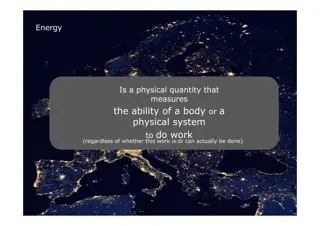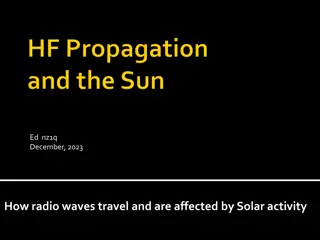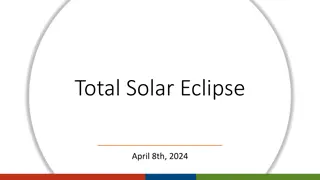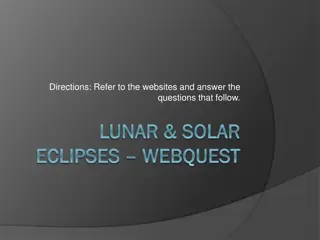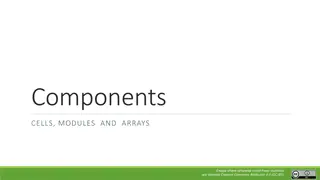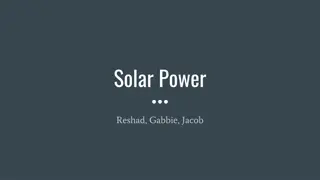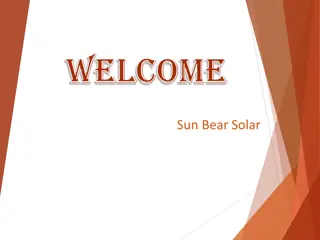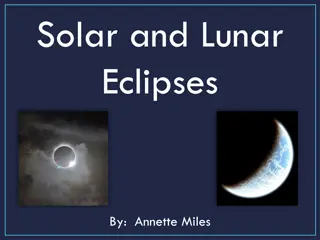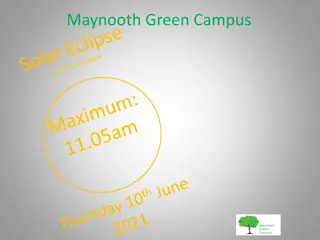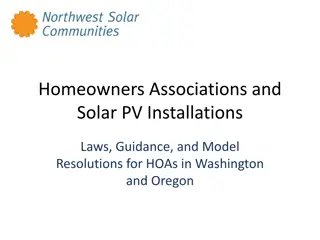Eclipse Exploration: Total Solar Eclipse Project and Programs Overview
Explore the Total Solar Eclipse Project that has ventured through various countries over the years, capturing stunning images and sharing eclipse timelines. Discover the path of totality and delve into the programs offered, including webcasts, blogs, videos, and telescope feeds. Learn about the upcoming events and how to engage with the eclipse experience through multiple platforms.
Download Presentation

Please find below an Image/Link to download the presentation.
The content on the website is provided AS IS for your information and personal use only. It may not be sold, licensed, or shared on other websites without obtaining consent from the author.If you encounter any issues during the download, it is possible that the publisher has removed the file from their server.
You are allowed to download the files provided on this website for personal or commercial use, subject to the condition that they are used lawfully. All files are the property of their respective owners.
The content on the website is provided AS IS for your information and personal use only. It may not be sold, licensed, or shared on other websites without obtaining consent from the author.
E N D
Presentation Transcript
Exploratoriums eclipse history 1998 Aruba 1999 Turkey 2001 Zambia 2006 Turkey (again) 2008 China 2016 Micronesia 2017 U.S.A. (August 21)
Eclipse Timeline These times are for the eclipse itself, not the broadcasts 1stContact Weds, March 9, 2016 Tues, March 8, 2016 Tues, March 8, 2016 Weds, March 9, 2016 00:09:59 UTC 7:10 PM EST 4:10 PM PST 10:10 AM CHUT Woleai Atoll, Micronesia Washington, DC San Francisco 2ndContact (Totality Begins) (duration: 4 min, 5 seconds) Weds, March 9, 2016 Tues, March 8, 2016 Tues, March 8, 2016 Weds, March 9, 2016 01:38:07 UTC 8:38:07 PM EST Washington, DC 5:38:07 PM PST San Francisco 11:38:07 AM CHUT Woleai Atoll, Micronesia 4thContact Weds, March 9, 2016 Tues, March 8, 2016 Tues, March 8, 2016 Weds, March 9, 2016 03:14:39 UTC 10:14 PM EST 7:14 PM PST 1:14 PM CHUT Woleai Atoll, Micronesia Washington, DC San Francisco
The path of totality: Woleai Atoll is just before the location of greatest duration
Our Programs We are producing: Webcasts, blogs, videos, and dispatches from the crew in Micronesia available at: www.exploratorium.edu/eclipse 2 broadcasts available via satellite: one is just telescope imagery & one is an educational program 4 different webcast streams: telescopes without sound, educational program, telescopes with sonification, telescopes with Spanish language commentary Android App with maps, telescope & program webcasts, and real time Twitter conversations Prior to event day, social media build up on FB, Twitter, Tumblr, and YouTube (details follow)
Telescope only feeds This feed will be a mix from four telescopes There are 2 audio tracks: one is silent, one has a sonification Weds, March 9, 2016 Tues, March 8, 2016 Tues, March 8, 2016 Weds, March 9, 2016 Starts 00:00:01 UTC 7:00 PM EST 4:00 PM PST 10:00 AM CHUT 1:15 PM CHUT Ends 03:15:00 UTC 10:15 PM EST 7:15 PM PST Available via satellite on Galaxy 17 13K upper (Orb Loc: 91' W; U/L: 14269Mhz Vertical; D/L: 11969Mhz Horizontal) Audio Channel 1: MOS Audio Channel 2: Sonification Available as two separate webcasts (one with each audio channel) at www.exploratorium.edu/eclipse Also Available on Android App (free on Google Play) as Exploratorium Eclipse And on NASA TV, channel 2
Program (Education) Feed A one-hour educational program featuring scientists & educators, hands-on demonstrations, and telescopes imagery Weds, March 9, 2016 Tues, March 8, 2016 Tues, March 8, 2016 Weds, March 9, 2016 8:00 PM EST 5:00 PM PST 11:00 AM CHUT Starts 01:00:00 UTC 02:00:00 UTC 9:00 PM EST 6:00 PM PST Ends 12:00 PM CHUT Available via satellite on Galaxy 17 13K upper (Orb Loc: 91' W; U/L: 14269Mhz Vertical; D/L: 11969Mhz Horizontal) Available as a webcast www.exploratorium.edu/eclipse Also Available on Android App (free on Google Play) as Exploratorium Eclipse And on NASA TV, channel 1
Telescope Imagery with Spanish commentary A 30-minute program around totality that will utilize the telescope feed as imagery with added audio commentary in Spanish by Dr. Isabel Hawkins Weds, March 9, 2016 Tues, March 8, 2016 Tues, March 8, 2016 Weds, March 9, 2016 Starts 01:15:00 UTC 8:15 PM EST 5:15 PM PST 11:15 AM CHUT Ends 01:45:00 UTC 8:45 PM EST 5:45 PM PST 11:45 PM CHUT Not available on satellite, only online streaming at: www.exploratorium.edu/eclipse
Our script outline Establishing shots/welcome About the Telescopes (and images) Eclipse 101 (demo/animation of alignment) Moon casting shadow on Earth Why Woleai (path of totality, weather) Local Color (chief, b-roll of culture days) Space Weather (animation, sun bombards us with particles that create aurora at the poles) Magnetosphere (protects us from sun) Prepare for totality (Bailey s beads, diamond ring, corona) 4 min & 5 seconds of totality Prepare for 2017 eclipse across US How to build a solar viewer Thanks, credits
Additional Story ideas NASA sends local museum folks to do broadcast 4000 pounds of gear, including a c-band satellite dish 15 crew (including talent) 22 hours on plane, 3 days on boat Weather predictions for the Woleai atoll are 55-60% clear skies .but they are adjusted by 10-15% because it is an El Nino year. So we are at 65-75% chance of clear skies. Our contact on Woleai just notified us that they are experiencing drought conditions (and they would not be able to share any drinking water with the crew) Jay Anderson http://home.cc.umanitoba.ca/~jander/tot2016/tot2016.htm Eclipse History Ancient Chinese believed Celestial Dragon was eating sun (and they would bang on pots and pans to scare it away) Ancient Mayans, using only naked-eye observing, predicted eclipses for hundreds of years into the future The Chippewa Indians in N America shot flaming arrows at the sun hoping to rekindle it An Eclipse was used to verify Einstein s General Theory of Relativity Exo planets (earth-like planets revolving around stars) are discovered by mini-eclipses These planets (over 1,000 so far) are found by astronomers noticing a dimming in the light coming from a star. The light dims as the planet passes in front of it Next major eclipse is on August 21, 2017 Assets/maps are available at https://svs.gsfc.nasa.gov/cgi-bin/search.cgi?value=2017+eclipse&expanded=filters
Fun Eclipse Facts Total solar eclipses are not rare, occurring roughly every year and a half. But each one is visible from only a very limited area on Earth. To produce a total eclipse, the sun, moon, and Earth need to line up in a straight line. Astronomers call this syzygy (pronounced siz-i-gee). The path from which a total solar eclipse is visible the path of totality is less than170 miles wide. During an eclipse, the moon s shadow races across the Earth faster than the speed of sound, more than 1,200 miles an hour. On either side of the path of totality is a region you might call the path of partiality. From there, you can see a partial eclipse. Solar and lunar eclipses happen in pairs, or sometimes even trios. The full moons on either side of a solar eclipse are liable to be eclipsed as well. (This eclipse will be followed by a lunar eclipse two weeks later, on March 23.) From Earth, you see an eclipse as the moon passing in front of the sun and blocking its light. From the International Space Station, you d see it as the moon s shadow cast upon the Earth, moving swiftly across its surface. (You might also see the moon passing in front of the sun.) (possible images: eclipse shadow from space, https://www.youtube.com/watch?v=VenATs6mP8U With the caveat: http://blogs.discovermagazine.com/badastronomy/2012/05/22/a-fake-and-a-real-view-of-the- solar-eclipse-from-space/#.VqaxLlLDfmE ) If the moon were any other size, we would not have the total solar eclipses we do. If the moon were much bigger, it would block out both the sun and its corona; smaller and it would not cover the sun completely. continued on next slide ..
Fun Eclipse Facts (cont.) If the moon were at any other distance from Earth, we would not have the total solar eclipses we do. If the moon were closer, it would block out both the sun and its corona; farther away and it would not cover the sun completely. A curious coincidence makes the total solar eclipse possible: The sun is 400 times the diameter of our moon, but it's also 400 times farther away from us--so both bodies appear to be the same size in the sky, and the moon perfectly covers the sun. A solar eclipse happens only during a new moon. Likewise, a lunar eclipse happens only during a full moon. Earth is the only planet in our solar system from which you can witness a perfect total solar eclipse. No other planet has the right-size moon. Other planets have moons (Jupiter has 6, Uranus 12, Neptune 7, and Pluto 3), but when their moons block the sun, they block it completely, covering the solar corona as well as the body of the sun. If you stood in one place and waited to see a total solar eclipse, you could wait for 300 years or more. (ask Paul D. or use world map. Find updated version of this: https://www.exploratorium.edu/eclipse/future.html look on mr.eclipse site.)
This is a still image of a great animation made for us by NASA of the path of totality It is available for use, at broadcast resolution here: https://svs.gsfc.nasa.gov/cgi-bin/details.cgi?aid=4427 Also available for 2017 at https://svs.gsfc.nasa.gov/cgi- bin/search.cgi?value=2017+eciipse&expanded=filters
Another still of an animation that shows the shadow moving across earth Available at broadcast resolution here: https://svs.gsfc.nasa.gov/cgi-bin/details.cgi?aid=4424&button=recent Also available for 2017 eclipse at https://svs.gsfc.nasa.gov/cgi-bin/search.cgi?value=2017+eciipse&expanded=filters
The third animation, available for download at https://svs.gsfc.nasa.gov/cgi-bin/details.cgi?aid=4426&button=recent Also available for 2017 eclipse at https://svs.gsfc.nasa.gov/cgi-bin/search.cgi?value=2017+eciipse&expanded=filters
Great stills of totality are available at mreclipse.org He asks for a credit only This site is by Fred Espenak, the most famous of all eclipse chasers and a retired NASA scientist The Exploratorium has produced 10 videos available on our website (and embeddable) on safe viewing, celestial mechanics, Einstein s Light Bending concept, etc. www.exploratorium.edu/eclipse
Exploratorium Local Contacts eclipse@exploratorium.edu Producer: Nicole Minor nminor@exploratorium.edu
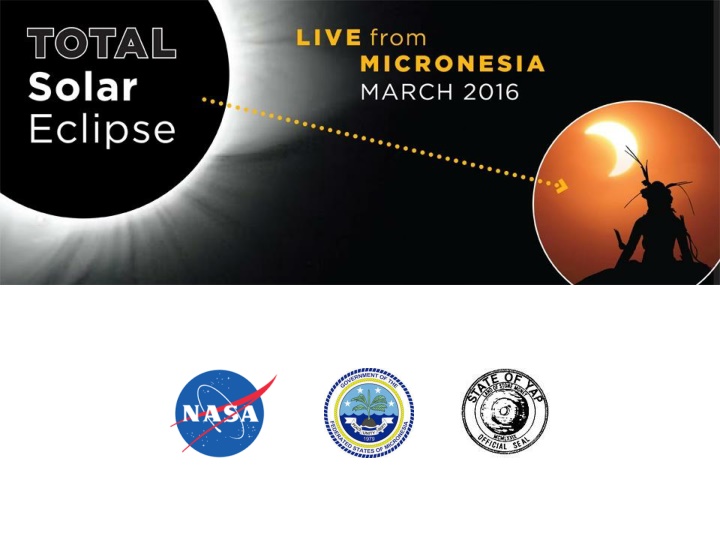


![[PDF⚡READ❤ONLINE] Road Atlas for the Total Solar Eclipse of 2024 - Color Editio](/thumb/21696/pdf-read-online-road-atlas-for-the-total-solar-eclipse-of-2024-color-editio.jpg)


